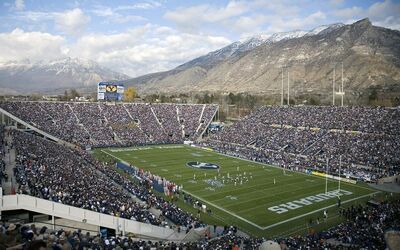
LaVell Edwards Stadium is an outdoor athletic stadium in Provo, Utah on the campus of Brigham Young University. Primarily used for college football, it is the home field of the BYU Cougars. The playing field is natural grass and is at an elevation of 4630 feet (1411 m) above sea level. The field runs in the conventional nourth-south direction, with the press box along the west sideline.
History and Seating[]
The stadium opened on the north end of campus in 1964 as Cougar Stadium, replacing a smaller, 5,000-seat stadium of the same name. The capacity of the facility was just under 30,000 with stands on both sides of the playing field. Seating was soon added to make room for 35,000 fans. Temporary bleachers placed at the back of the end zones raised the capacity to 45,000. The stadium was expanded in 1982 to accommodate more than 65,000; permanent concrete stands in the end zones, separated by entryways from the east and west grandstands, were put in place of the temporary bleachers. The playing field was lowered eight feet (2.4 m), and the running track was removed. Following the retirement of legendary head coach LaVell Edwards after the 2000 football season, the stadium was renamed in his honor.
To increase revenue, the stadium was renovated in 2003 to provide more luxury seating, which resulted in a slight reduction of seating capacity to 64,045. The luxury seating was a noticeable addition because the arrangement of blue and white seats in this section spell out BYU in block letters. On August 30, 2008, BYU unveiled a new video board on the north endzone, allowing fans seated in the south endzone to see the instant replays and graphics which previously were shown only on the south board. During the summer of 2010, the capacity of the stadium was further reduced due to some renovations that allowed for more wheelchair accessibility. Currently, a crowd of 63,725 (or more) is considered a sellout at LaVell Edwards Stadium.
Exterior of stadium[]
Track and field
Prior to the 1982 expansion, the stadium hosted events for BYU's outdoor track and field teams. In fact, the stadium hosted the NCAA Track and Field Championships in 1967 and 1975.[1] With the removal of the track from Cougar Stadium (as it was still known at that time), a new track facility was built just south of the stadium - it was later named the Clarence F. Robison Track to honor the team's legendary former coach.
Jurassic fossils under the stadium[]
Part of the largest collection of Jurassic period fossils in North America, housed at BYU, was stored underneath the east bleachers of the stadium until 2005. The fossils have since been prepared and are on display in the BYU Earth Science Museum's collection room.[2][3][4]
Security[]
Due to installation of new features in the stadium, the grounds crew and BYU Police have installed a number of security features to prevent students from entering the stadium after hours, including security cameras and motion detectors. Anyone found entering the stadium after hours may be charged with trespassing and receive a fine.
Renovations and Future Expansion[]
The stadium will undergo some upgrades starting in the 2011 season. By 2012, the student section will be unified in one section instead of being scattered throughout the stadium; new HD jumbotrons will face the north and south endzones, replacing the outdated and smaller video screens. The twin towers have been freshly coated to reflect the new BYU "Blue" color scheme